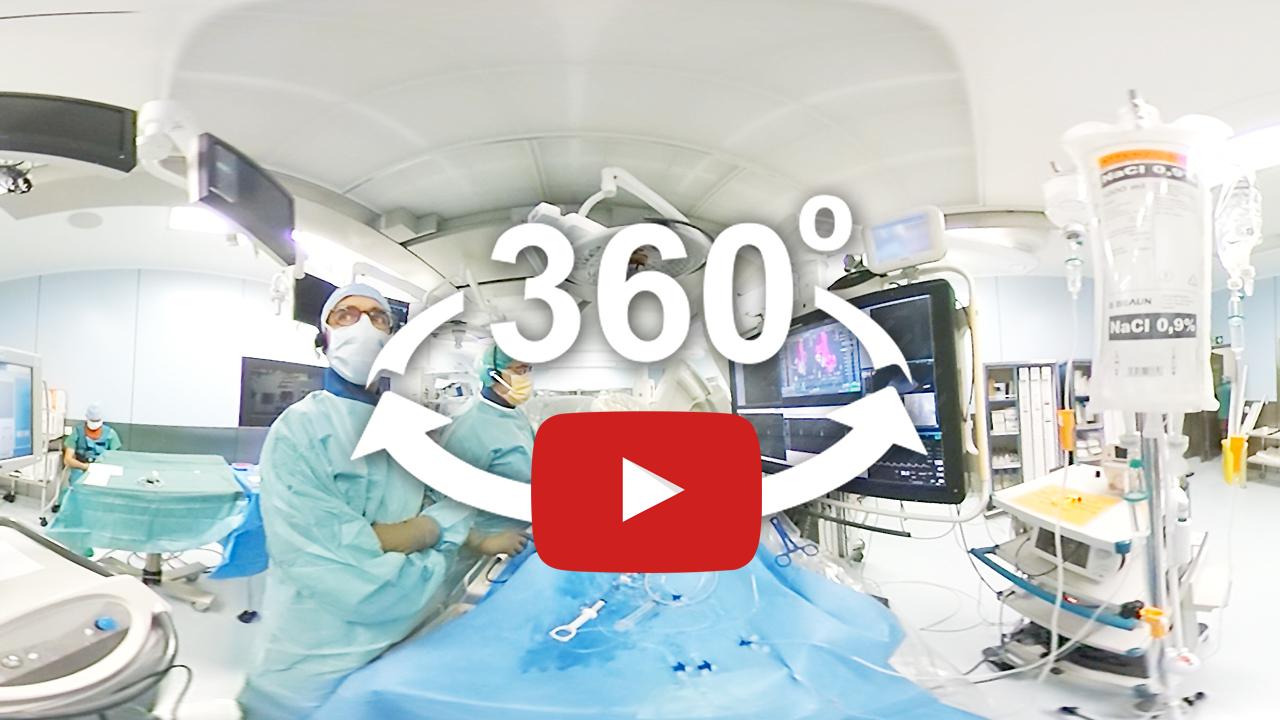Hybrid Room
Hybrid Room
The word “hybrid” in nature indicates something that comes from the crossing of related species or different breeds of the same species. This definition allows us to understand why an operating room takes the name of “hybrid”.
In hybrid room we are in a surgical room but also in a catheterization room along with a diagnostic laboratory. We do a mistake if we think that this room is only a sum of the above descriptions.
One of the key advantages of this room is the top technological equipment. In a modern Hybrid Room, you can perform a technologically advanced procedure without any compromise like open-heart surgery and at the same time, on the same patient, may be performed a diagnostic or interventional procedure, with the same precision with which it is normally performed in a cardiac catheterization laboratory or in a dedicated angiography room.
La Sala Ibrida

The 360° Hybrid Room and the room under construction.
(360° music: www.bensound.com)
The main advantages of a structure of this type are :
- Ability to perform procedures already known with a greater level of precision and accuracy.
- Increased safety for the patient for the presence of several specialists.
- Rationalization of operations.
- Time and resources saving.
But for a structure so evolved outline can be reductive; to fully understand the innovation introduced we need to know from where comes the need to achieve it.
The birth of a unit of this type (it was build at Cardiocentro in three months during 2013 ) comes mainly from the growth of the possibilities of endovascular intervention, first in coronary disease and now increasingly also in the treatment of valvular disease, but also for the new phenomenon that involves us namely the patient’s transformation. Today the aging of the population puts us more and more often in front of patients with a higher risk profile, often with the addition of important diseases or with an higher degree of cardiac or vascular disease. In order to make less stressing procedures, for this kind of patient, the medical world has developed less invasive procedures to treat the patient with less risk.
Among the less invasive methods we can mention:
- implantation of aortic valve prosthesis for percutaneous femoral or transapical,
- the mitral clip percutaneous implantation via femoral vein,
- the endoprosthesis for implantation into the aorta via the femoral surgery for the treatment of aneurysms,
- the closure of septal defects via transcatheter with occluding system at umbrella,
- the implantation of prosthetic aortic valve or mitral surgically minimally invasive,
- the correction of cardiac arrhythmias with transfemoral catheterization.
These methods are in an area of intersection between the skills historically assigned to the surgeon and the skills relating to the interventional cardiology. These procedures can be made optimally only in a specific place: Hybrid Room.
In this structure, as we have already mentioned, you can move from an endovascular procedure to a surgical procedure; you can use the finer diagnostic imaging during the intervention, without moving the patient and can be performed more combined interventions on the same patient in the same operating session (for example a bypass operation on some coronary arteries and stent implantation in other coronary arteries or the laying of a stent it may be associated with a valve for surgical intervention on) without having to subject the patient to more distinct narcosis and avoiding re-hospitalizations.
As we saw the hybrid room has an inescapable multidisciplinary approach and not is no coincidence that the overall responsibility of the room has been assigned to the service of Cardioanaesthesia and Intensive care directed by Prof. Dr. Tiziano Cassina.
Such an innovative structure also had to be absolutely safe for the patient and therefore every possible risk was been avoided. In this way, we have worked to ensure that the boundary place between cardiology and cardiac surgery don’t will be an indefinite place where there will be not coordination and organization, fundamental elements to patient safety.
Interventional cardiology and cardiac surgery have a common denominator which is the anesthesiologist’s presence that becomes the warranter of the good level of coordination and organization.
The anesthetist is located in an ergonomically ideal environment since it is located in a modern operating room technologically equipped to allow the surgeon or interventional cardiologist to see and operate without cutting, or cutting as little as possible. The future is more and more clearly in this direction and therefore it’s a good innovation, if it will bring improvements, and will certainly lead them, in the quality of care and patient safety.
The head of the Hybrid Room is Prof. Dr. Tiziano Cassina head of Cardioanaesthesia and Intensive care. The Hybrid Room management is of “the office planning and scheduling procedures” and Dr. Marco Moccetti, chief of Laboratories “Horten”.
We are building the new Hybrid operating room
Via Tesserete 48
CH-6900 Lugano
info.icct@eoc.ch
Medical Direction


